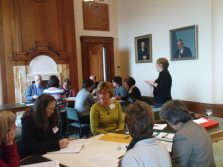I’m spending an hour or so this morning reading through a couple of reports. One is from the Scottish Library & Information Council/CILIPS and is entitled A Guide to using Web 2.0 in Libraries (weighting in at a digestible 10 pages). The other is from the LISU at Loughborough (including my team’s very own Valérie Spezi) and is called PEER Behavioural Research: Authors and Users vis-à-vis Journals and Repositories (93 pages).
Web 2.0
This is a handy sized report that while it perhaps tells me nothing new, is an excellent synthesis of the highlights of using Web 2 and social networking within libraries. More seriously interested librarians might find it a little light for their taste, and the lack of references for further reading does harm its scholastic qualities. However, for those looking to get a handle on the terminology and potentialities of these tools then this is a fine introduction. The report moves through the why use it, the benefits and then into the implementation. It also considers the staffing and potential legal implications of Web 2 (which in itself could have probably filled the whole report). Finally it looks at integrating Web 2 within organisational systems (human and technical).
PEER
How authors view the whole journal and repository scene today is something that’s been of interest for a few years, so I was pleased to have a read through this report. By its very nature it is very scholarly and gives an excellent overview of the scholarly communication and publications fields developments over the last ten years. The comments on academic’s searching habits are quite telling (a narrowing of focus and restriction to trusted searches and information sources, replacing broader views). From a library perspective the note that the average number of articles read by academic authors has increased over the years is a shocking one, as we try and maintain journal collections against rising costs (although healthy for the interlending and open access communities)
Ave articles read/year
- 1977: 150
- 2000: 216
- 2009: 280
There is a very good overview of the citation enhancement effect of open access materials – and the questions that remain to be answered in this respect. While it is one of those qualities of a repository that we IR managers so often espouse, there is a certain truth that should we ever reach a level playing field of 100% open access, that this advantage would dwindle to nothing.
The report also covers the dynamic and changing field within which repository managers operate, and the challenges they face; not least among them engagement and education of our local academic authors. I know personally that I am still talking to many, many authors about the same issues as I was back in 2006. These contacts are generally very positive, but it does indicate the somewhat herculean task we still face in bringing OA up the academic agenda. As one academic I know often says “I’ve got so many other pressing and urgent priorities, the repository just isn’t one of them”. No wonder we’ve seen the rise of the mandate. And this comment is mirrored on p55 of the report.
The report goes on to detail the methodology behind their work. I was interested to see that out of over 2400 scholars invited to attend their focus groups, only 21 attended. I will feel less down-heartened next time I have a poorly attended focus group myself.
The report then moves on to look at the findings of the academics surveyed and interviewed, with respect to repositories and open access. I would highly recommend any repository manager, and indeed any academic with an interest in scholarly communication, to read through these results. They make for sobering, if not at all suprising, reading – at best 30% of academics are aware they have an IR.
I was interested to note (p32) that the study suggested arts and social science academics were more likely to deposit in the IR. Here at Leicester it has been fairly even across the board from all disciplines. The section on drivers/barriers to deposit is worth looking at (free access in #1 driver, whereas worries over (c) infringement are the top worry). That said (p41) shows that 2/3 of the sample feel there is a role for repositories in scholalry communications, with most of the rest unsure rather than negative. There are some good pull out quotes in the results of the focus group, although given their small sample it’s hard to attribute any great validity to them – much as I can see myself using them in future presentations (especially the “online access doesn’t mean the same as open access”
Information seeking for open access papers relates nicely to a question was asked in Cell Physiology, and seems in this study as well that authors seldom look to OA sources to retrieve their scholarly information. Indeed it seems the grey trade in PDFs between authors (p61) continues to be the major route to access items that they are not subscribed to in many cases.
This is a very rich report and rather than comment on their conclusions, I’d simply point you towards reading it and forming your own judgements. I found for my own part that a lot of what they elicited matched with my experiences across a number of universities. The one thing I didn’t get from the report (and perhaps that wasn’t their aim) was the opinion or feeling of academics towards the effectiveness and operation of their institutional repositories. If anyone knows of any work looking at that, I’d be interested to hear about it!
 This talk aimed to take a more practical overview of the same issue, which started with Morag giving an overview of Glasgow’s repository. Like Leicester they aimed to join the repository and publications database together. It was important to develop policies and procedures to enable departments to engage with the repository on an on-going basis. Started by going out to talk to HoDs and research chair/champions in each department. Gathered information on their current practices on how they gathered current procedures. Self deposit for two depts, mediated for large faculties and proxy for most small to medium sized departments. Issue with materials in PMC going unharvested.
This talk aimed to take a more practical overview of the same issue, which started with Morag giving an overview of Glasgow’s repository. Like Leicester they aimed to join the repository and publications database together. It was important to develop policies and procedures to enable departments to engage with the repository on an on-going basis. Started by going out to talk to HoDs and research chair/champions in each department. Gathered information on their current practices on how they gathered current procedures. Self deposit for two depts, mediated for large faculties and proxy for most small to medium sized departments. Issue with materials in PMC going unharvested. It seemed a long way to go, longer than going to
It seemed a long way to go, longer than going to  The feeds issue means that a lot of different departments and stakeholders within an institution are involved in the issue (finance, research, administrative staff, library, committees etc). No matter what they do, institutions need to coordinate these funds centrally and along the lines of acceptable standard policies. Edinburgh will be introducing a mandate in Jan 2010 and are spending the 6 months in the lead up to that talking with departments about how this will impact and how the repository can help them to meet the requirements of this. Noted that once you have introduced the idea of a central fund to pay for publication, top sliced from research grants, you have to maintain it – even if income decreases.
The feeds issue means that a lot of different departments and stakeholders within an institution are involved in the issue (finance, research, administrative staff, library, committees etc). No matter what they do, institutions need to coordinate these funds centrally and along the lines of acceptable standard policies. Edinburgh will be introducing a mandate in Jan 2010 and are spending the 6 months in the lead up to that talking with departments about how this will impact and how the repository can help them to meet the requirements of this. Noted that once you have introduced the idea of a central fund to pay for publication, top sliced from research grants, you have to maintain it – even if income decreases. I’ve just been reading an article “
I’ve just been reading an article “ As I mentioned earlier the rest of the paper is a guide to services that the author has employed in the deliverance and indeed furtherance of the research support agenda. It seems strangely at odds with the earlier half of the paper, moving to pure practicality from scholastic theory and review. In many regards I would have been interested to read this in some more detail as a paper in its own rights.
As I mentioned earlier the rest of the paper is a guide to services that the author has employed in the deliverance and indeed furtherance of the research support agenda. It seems strangely at odds with the earlier half of the paper, moving to pure practicality from scholastic theory and review. In many regards I would have been interested to read this in some more detail as a paper in its own rights. Glad to see that repository managers and libraries are stakeholders. Actually, I’d have been happier to see libraries paired off as a 5th separate stakeholder as I don’t believe that library interests and those of repositories are strictly speaking coterminus. Repository administration is often, but not always, based within a library but this can be a marriage of convenience – a functional – decision rather than a strategic one. Perhaps this is an area PEER needs to think about carefully.
Glad to see that repository managers and libraries are stakeholders. Actually, I’d have been happier to see libraries paired off as a 5th separate stakeholder as I don’t believe that library interests and those of repositories are strictly speaking coterminus. Repository administration is often, but not always, based within a library but this can be a marriage of convenience – a functional – decision rather than a strategic one. Perhaps this is an area PEER needs to think about carefully. I was at an event in Aberwyswyth at the
I was at an event in Aberwyswyth at the  After lunch we had a series of mini-case studies, starting from
After lunch we had a series of mini-case studies, starting from  She looked at ROAR, Intute RS and OAIster as resources for increasing visibility of repository contents; and how they are not well known by the common librarian or academic. Then it was looking at
She looked at ROAR, Intute RS and OAIster as resources for increasing visibility of repository contents; and how they are not well known by the common librarian or academic. Then it was looking at